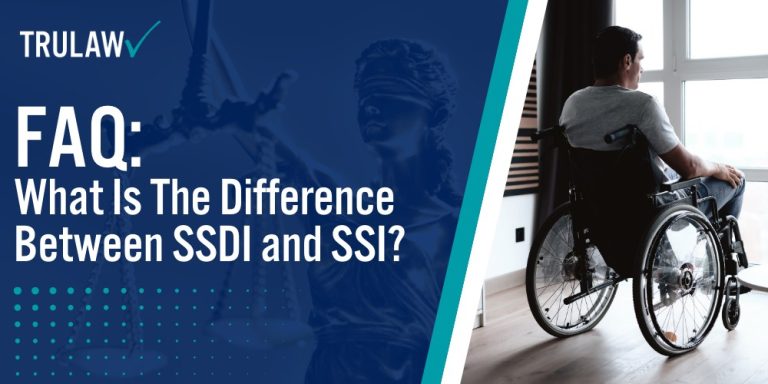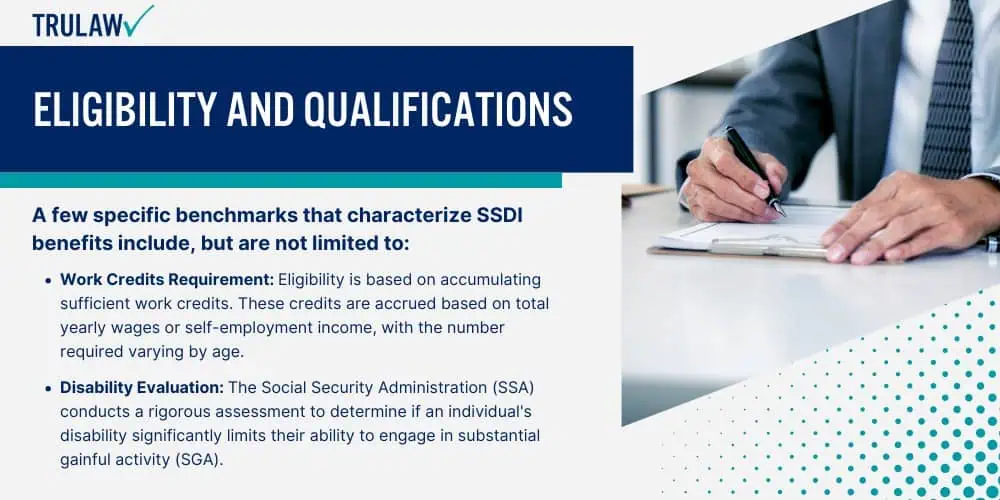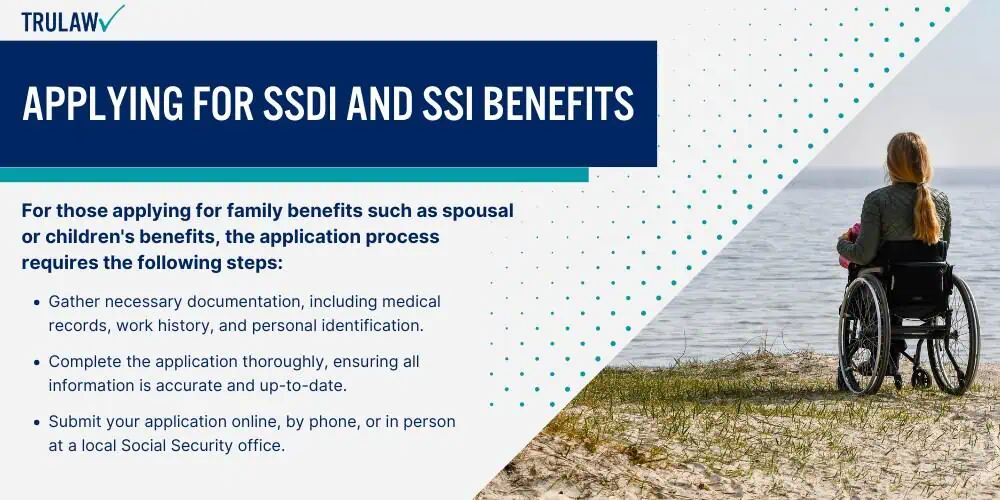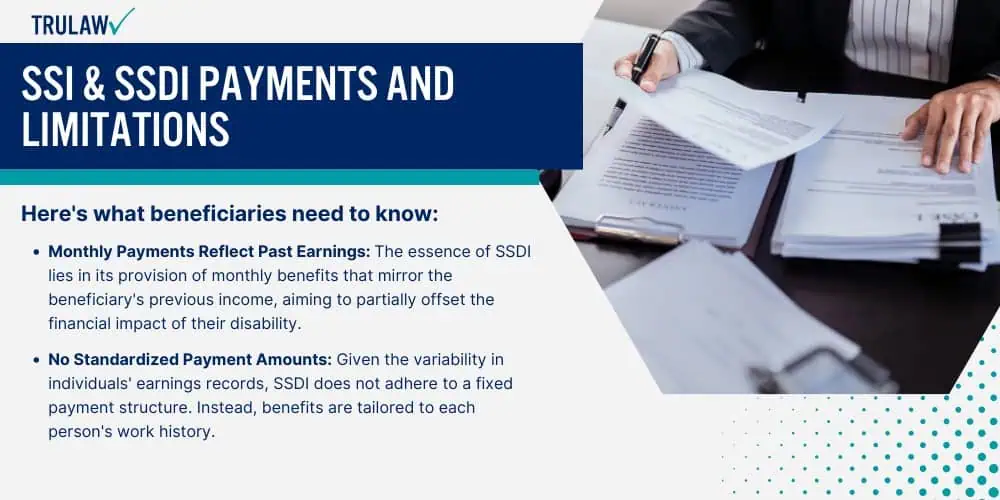What Is The Difference Between SSDI and SSI?
- Last Updated: December 16th, 2025

Attorney Jessica Paluch-Hoerman, founder of TruLaw, has over 28 years of experience as a personal injury and mass tort attorney, and previously worked as an international tax attorney at Deloitte. Jessie collaborates with attorneys nationwide — enabling her to share reliable, up-to-date legal information with our readers.
Legally Reviewed
This article has been written and reviewed for legal accuracy and clarity by the team of writers and legal experts at TruLaw and is as accurate as possible. This content should not be taken as legal advice from an attorney. If you would like to learn more about our owner and experienced injury lawyer, Jessie Paluch, you can do so here.
Fact-Checked
TruLaw does everything possible to make sure the information in this article is up to date and accurate. If you need specific legal advice about your case, contact us by using the chat on the bottom of this page. This article should not be taken as advice from an attorney.
Key takeaways:
- SSDI assists people who have worked and paid into the Social Security system, providing benefits based on their earnings and work credits. SSI helps those with limited income and resources regardless of work history.
- To qualify for SSDI, you need a sufficient number of work credits; to be eligible for SSI, your financial situation must be below specific thresholds set by the program.
- While SSDI beneficiaries are eligible for Medicare after two years, SSI recipients can often qualify for Medicaid immediately.
What is the Difference Between SSDI and SSI?
On this page, we’ll discuss how SSDI and SSI differ, what are their eligibility criteria, who qualifies to file an SSDI Lawsuit, and much more.
Intro To SSDI Lawsuit
Understanding the labyrinth of disability benefits can often feel overwhelming, with acronyms like SSDI and SSI creating confusion for many seeking assistance.
As an expert in Social Security programs with years of experience navigating these waters,
We are here to clarify the distinctions between Social Security Disability Insurance (SSDI) and Supplemental Security Income (SSI).
Both are critical programs the Social Security Administration runs to support individuals who cannot work due to disability.
.

While they may seem similar at first glance, SSDI and SSI serve different populations based on distinct eligibility requirements—one rooted in work history and another in financial need.
This article is grasping this distinction is crucial—not only could it determine which program you qualify for and how much assistance you receive.
Stay informed; read on to unravel this complexity.
Table of Contents
Filing For SSDI and SSI Benefits
Social Security Disability Insurance (SSDI) and Supplemental Security Income (SSI) are critical components of the social safety net administered by the Social Security Administration (SSA) to provide disability benefits to eligible individuals.
While both programs aid those with disabilities, they have distinct eligibility requirements and funding sources.
Differences Between SSDI and SSI Benefits
The main difference between Supplemental Security Income (SSI) and Social Security Disability Insurance (SSDI) is that SSI is an entitlement program with no work-related requirements, whereas SSDI is an earned benefit that has work requirements to qualify.
Both programs pay monthly benefits to people with disabilities.
Social Security Disability Insurance: provides benefits to disabled or blind persons who are “insured” by workers’ contributions to the Social Security trust fund.
These contributions are based on your earnings (or those of your spouse or parents) as required by the Federal Insurance Contributions Act (FICA).
Your dependents may also be eligible for benefits from your earnings record.
Supplemental Security Income: distributes cash assistance payments to aged, blind, and disabled persons (including children) who have limited income and resources.
The Federal Government funds SSI from general tax revenues.
Many states pay a supplemental benefit to persons in addition to their Federal benefits.
It’s important to note that although both SSDI and SSI are disability programs, they have very important differences in the rules affecting eligibility and benefit payments.
Eligibility and Qualifications
Eligibility for Social Security Disability Insurance (SSDI) and Supplemental Security Income (SSI) is determined through distinct criteria focusing on an individual’s work history, income levels, and the severity of their disability.

SSDI Eligibility Criteria
SSDI is designed for individuals who have engaged in work activities and contributed to Social Security through payroll taxes.
A few specific benchmarks that characterize SSDI benefits include, but are not limited to:
- Work Credits Requirement: Eligibility is based on accumulating sufficient work credits. These credits are accrued based on total yearly wages or self-employment income, with the number required varying by age.
- Disability Evaluation: The Social Security Administration (SSA) conducts a rigorous assessment to determine if an individual’s disability significantly limits their ability to engage in substantial gainful activity (SGA).
- Age Consideration: While SSDI is generally aimed at individuals who are below retirement age, specific rules apply, such as for those with a disability that started before age 22, who may qualify under a parent’s work credits.
- Duration of Disability: The disability must be expected to last for at least one year or result in death.
SSI Eligibility Criteria
SSI targets individuals with limited income and resources, providing financial assistance regardless of work history.
The eligibility for SSI is based on a variety of factors, such as:
- Financial Thresholds: SSI requires that income and resources not exceed certain limits, which are periodically adjusted to reflect cost-of-living changes.
- Disability or Age Requirements: Applicants must meet the SSA’s definition of disabled or be aged 65 or older. Special considerations apply to children with disabilities.
- Residency and Citizenship: Eligibility is also contingent on being a resident of the United States or a qualified non-citizen and specific other residency requirements.
- Application for Other Benefits: Applicants must apply for any other cash benefits or pensions for which they might be eligible, including SSDI.
SSI and SSDI serve as pivotal elements of the United States’ social security system, offering vital support to individuals facing significant disabilities or financial needs.
Applying for SSDI and SSI Benefits
When applying for SSDI or SSI benefits, it’s important to understand the distinction between the application processes for these two programs.
Accurate and complete submission of required documents is crucial for a smooth application process.

SSDI Application Process
The SSDI application process necessitates that the applicant provides comprehensive medical evidence to support their claim of disability.
They require proof of a significant work history from which the work credits are derived.
For those applying for family benefits such as spousal or children’s benefits, the application process requires the following steps:
- Gather necessary documentation, including medical records, work history, and personal identification.
- Complete the application thoroughly, ensuring all information is accurate and up-to-date.
- Submit your application online, by phone, or in person at a local Social Security office.
- Follow up regularly on your application status and be prepared to provide additional information if requested.
The Social Security Administration (SSA) assesses whether an individual has accumulated enough credits to be eligible for SSDI.
It’s advisable to start the process by checking eligibility information through government information services online.
SSI Application Process
SSI, on the other hand, is designed for individuals who have limited income and resources.
The application process for SSI does not require work credits but does necessitate proof of age, disability, or blindness, along with financial criteria that fall within stipulated limits.
To apply for SSI, prospective beneficiaries should also gather pertinent medical evidence and financial information.
While individuals can begin their Social Security disability application online, completing the process often requires additional steps, such as:
- Check eligibility criteria concerning income and resources.
- Complete the online disability report if applicable.
- Attend an interview to furnish additional details and complete the process.
For both SSDI and SSI, the review process may take several months, during which additional information may be requested.
Once approved, receiving benefits will typically commence after a specific waiting period, and beneficiaries will be notified of the monthly benefits amount they are to receive.
SSI & SSDI Payments and Limitations
Both SSDI and SSI programs are important for individuals with disabilities, but they operate differently.
Each program offers distinct support pathways, differentiated by its eligibility criteria, including work history, income levels, and resource limitations.

The Nuances of SSDI Benefits
For those qualifying for Social Security Disability Insurance (SSDI), the program acts as a crucial safety net, anchored by previous contributions to the Social Security system through work credits.
Here’s what beneficiaries need to know:
- Monthly Payments Reflect Past Earnings: The essence of SSDI lies in its provision of monthly benefits that mirror the beneficiary’s previous income, aiming to partially offset the financial impact of their disability.
- No Standardized Payment Amounts: Given the variability in individuals’ earnings records, SSDI does not adhere to a fixed payment structure. Instead, benefits are tailored to each person’s work history.
- A Waiting Period in Effect: Typically, beneficiaries have a five-month waiting period before receiving benefits, underscoring the importance of timely application following a disability’s onset.
- Transition to Retirement Benefits: Upon reaching retirement age, SSDI transitions to Social Security retirement benefits, maintaining the monthly payment amount without disruption.
Insights into SSI Benefit Structure
Turning our attention to Supplemental Security Income (SSI), this program extends a helping hand to those facing significant financial constraints.
Consider these pivotal aspects:
- Designed for the Most Vulnerable: SSI targets individuals who are disabled, blind, or aged 65 and above, prioritizing those with minimal income and resources.
- Independence from Work History: Unlike SSDI, SSI benefits are anchored in financial need rather than previous employment, ensuring support is available regardless of work history.
- A Cap on Benefits: The federal government dictates a maximum monthly benefit rate, which may be augmented by state contributions.
- Medicaid Eligibility: SSI beneficiaries often gain access to Medicaid, providing a crucial healthcare safety net alongside financial support.
- Income Adjusted Benefits: Monthly payments are calculated by subtracting any countable income from the Federal Benefit Rate (FBR), illustrating a direct link between financial need and benefit amount.
Through the tailored support of SSDI and SSI, individuals with disabilities find varying degrees of financial and healthcare assistance, reflecting the programs’ shared commitment to safeguarding the well-being of vulnerable populations.
Additional Benefit Considerations
When navigating the landscapes of Supplemental Security Income (SSI) and Social Security Disability Insurance (SSDI), it’s crucial for beneficiaries to understand how these disability programs interact with other benefits and what responsibilities come with receiving such assistance.
Impact on Other Benefits
The impact of Social Security Disability Insurance (SSDI) and Supplemental Security Income (SSI) on other benefits is significant and can be summarized as follows:
- Medicare: Individuals on SSDI are eligible for Medicare after a 24-month qualifying period, whereas SSI recipients may qualify for Medicaid immediately.
- Disabled Widow/Disabled Adult Child: Those receiving benefits as a disabled widow or disabled adult child must also consider how SSI and SSDI impact their current benefits. Eligibility for either program may affect the amount received from the other.
Responsibilities of Beneficiaries
It’s important to understand the following responsibilities of beneficiaries receiving SSDI or SSI:
- Reporting Requirements: Beneficiaries must report any changes in income or living situation to the Social Security Administration (SSA). Failure to comply can result in overpayment and sanctions.
- Federal Insurance Contributions Act (FICA): While SSDI beneficiaries have paid Social Security taxes through FICA, SSI beneficiaries are funded by general tax revenues and are not required to have a work history. Understanding these distinctions is crucial for compliance and maintaining eligibility.
Social Security Disability Insurance Frequently Asked Questions
-
Eligibility for SSDI is primarily based on an individual’s work history and the amount of Social Security taxes they have paid.
Conversely, SSI eligibility hinges on age, disability, or blindness and is means-tested, considering the applicant’s income and assets.
-
The benefit amount for SSDI is calculated using the beneficiary’s earnings record, reflecting how much they have contributed to Social Security.
On the other hand, SSI payments are determined by federal and varying state supplemental amounts, considering the individual’s income and resources.
-
The approval process for both SSDI and SSI involves assessing the medical eligibility of an applicant; however, SSDI also requires a review of the applicant’s work credits, while SSI reviews financial eligibility.
-
Receiving both SSDI and SSI benefits simultaneously is possible for individuals who meet the medical disability criteria and have limited income and resources, in addition to having a qualifying work history for SSDI.
-
SSDI eligibility requires a certain number of work credits, which are accumulated based on the total number of years worked and contributions to the Social Security system through payroll taxes.
SSI does not consider work history in its eligibility criteria.
-
Typically, SSDI offers higher monthly payments than SSI, as SSDI is based on the beneficiary’s earning history.
SSI payments are often lower and meant to provide for the basic needs of individuals with little to no income.

Managing Attorney & Owner
With over 25 years of legal experience, Jessica Paluch-Hoerman is an Illinois lawyer, a CPA, and a mother of three. She spent the first decade of her career working as an international tax attorney at Deloitte.
In 2009, Jessie co-founded her own law firm with her husband – which has scaled to over 30 employees since its conception.
In 2016, Jessie founded TruLaw, which allows her to collaborate with attorneys and legal experts across the United States on a daily basis. This hypervaluable network of experts is what enables her to share the most reliable, accurate, and up-to-date legal information with our readers!
Additional Social Security Disability Insurance resources on our website:
Here, at TruLaw, we’re committed to helping victims get the justice they deserve.
Alongside our partner law firms, we have successfully collected over $3 Billion in verdicts and settlements on behalf of injured individuals.
Would you like our help?
At TruLaw, we fiercely combat corporations that endanger individuals’ well-being. If you’ve suffered injuries and believe these well-funded entities should be held accountable, we’re here for you.
With TruLaw, you gain access to successful and seasoned lawyers who maximize your chances of success. Our lawyers invest in you—they do not receive a dime until your lawsuit reaches a successful resolution!
AFFF Lawsuit claims are being filed against manufacturers of aqueous film-forming foam (AFFF), commonly used in firefighting.
Claims allege that companies such as 3M, DuPont, and Tyco Fire Products failed to adequately warn users about the potential dangers of AFFF exposure — including increased risks of various cancers and diseases.
Depo Provera Lawsuit claims are being filed by individuals who allege they developed meningioma (a type of brain tumor) after receiving Depo-Provera birth control injections.
A 2024 study found that women using Depo-Provera for at least 1 year are five times more likely to develop meningioma brain tumors compared to those not using the drug.
Suboxone Tooth Decay Lawsuit claims are being filed against Indivior, the manufacturer of Suboxone, a medication used to treat opioid addiction.
Claims allege that Indivior failed to adequately warn users about the potential dangers of severe tooth decay and dental injuries associated with Suboxone’s sublingual film version.
Social Media Harm Lawsuits are being filed against social media companies for allegedly causing mental health issues in children and teens.
Claims allege that companies like Meta, Google, ByteDance, and Snap designed addictive platforms that led to anxiety, depression, and other mental health issues without adequately warning users or parents.
Transvaginal Mesh Lawsuits are being filed against manufacturers of transvaginal mesh products used to treat pelvic organ prolapse (POP) and stress urinary incontinence (SUI).
Claims allege that companies like Ethicon, C.R. Bard, and Boston Scientific failed to adequately warn about potential dangers — including erosion, pain, and infection.
Bair Hugger Warming Blanket Lawsuits involve claims against 3M — alleging their surgical warming blankets caused severe infections and complications (particularly in hip and knee replacement surgeries).
Plaintiffs claim 3M failed to warn about potential risks — despite knowing about increased risk of deep joint infections since 2011.
Baby Formula NEC Lawsuit claims are being filed against manufacturers of cow’s milk-based baby formula products.
Claims allege that companies like Abbott Laboratories (Similac) and Mead Johnson & Company (Enfamil) failed to warn about the increased risk of necrotizing enterocolitis (NEC) in premature infants.
Here, at TruLaw, we’re committed to helping victims get the justice they deserve.
Alongside our partner law firms, we have successfully collected over $3 Billion in verdicts and settlements on behalf of injured individuals.
Would you like our help?

